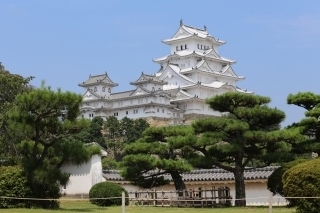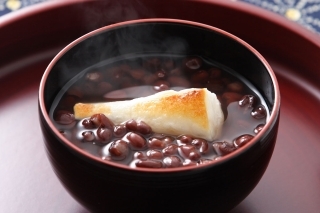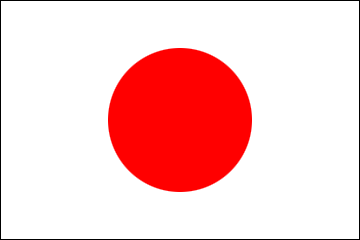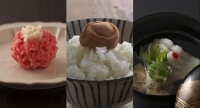Japanese Kitchen
2021/12/7
For our final recipe of 2021 we move from one port city in the east (Yokohama – home of our previous recipe) to the western city of Kobe in Hyogo prefecture. This time we have a sweet dish to introduce to you that is a winter-warmer favourite all over Japan. In fact, it is the first dessert recipe to be introduced so far in our series!
Zenzai (Red bean soup with mochi)
 Himeji Castle ©JNTO
Himeji Castle ©JNTO
Hyogo Prefecture in Japan’s western Kansai district has coastlines on two seas – the Sea of Japan in the north and Seto Inland Sea in the south. Kobe is the largest city in the prefecture and home of one of the largest ports in Japan. As with Yokohama, this gave the city much exposure to other nations and their cultures, and as a result Kobe is a very vibrant and multicultural city.
However, it is to Himeji that large numbers of tourists flock for its beautiful castle which was designated as a UNESCO World Heritage site in 1993 – one of the first in the country. Himeji Castle is a hilltop castle complex and is the largest and most visited castle in Japan. It is considered the finest surviving example of traditional Japanese castle architecture.
Among the delicacies of the prefecture, perhaps the best-known is Kobe beef. Famous around the world, this prime wagyu brand is known to fetch a staggering price at top-end restaurants. But perhaps lesser-known is that Hyogo prefecture also produces a top-end azuki bean known as Tamba Dainagon azuki. Azuki beans have consumed for over 5,000 years in Japan and to this day the country has the largest consumption per person in the world, producing some 80,000 tons per year. Although 90% of production now takes place in Japan's northernmost island of Hokkaido, Tamba Dainagon azuki beans are a much sought-after produce by wagashi shokunin (Japanese confectionery craftsmen) and currently there are about 1000 farms in the region that grow this particular type. The natural environment of the Tamba region provides specific conditions which create a larger bean packed full of umami that make it much sought-after.
Red in colour, azuki beans are considered auspicious and a must for special occasions, having been used at celebrations since long ago. Rich in vitamins and dietary fibre, the beans are also eaten as a food to wish for good health. The recipe introduced this month is often served at New Year and is a type of dessert soup that is slighty sweet with a subtle fragrance from the azuki beans. Known as zenzai in western Japan, the soup is served with toasted, chewy mochi that goes well with the sweet flavour. In eastern Japan, the same dish (called oshiruko) is prepared by crushing the boiled azuki beans into a smoother paste which gives a more watery soup. The recipe is simple to prepare and ingredients should be available at Japanese food stores. Why not give it a try over the winter months?!
However, it is to Himeji that large numbers of tourists flock for its beautiful castle which was designated as a UNESCO World Heritage site in 1993 – one of the first in the country. Himeji Castle is a hilltop castle complex and is the largest and most visited castle in Japan. It is considered the finest surviving example of traditional Japanese castle architecture.
Among the delicacies of the prefecture, perhaps the best-known is Kobe beef. Famous around the world, this prime wagyu brand is known to fetch a staggering price at top-end restaurants. But perhaps lesser-known is that Hyogo prefecture also produces a top-end azuki bean known as Tamba Dainagon azuki. Azuki beans have consumed for over 5,000 years in Japan and to this day the country has the largest consumption per person in the world, producing some 80,000 tons per year. Although 90% of production now takes place in Japan's northernmost island of Hokkaido, Tamba Dainagon azuki beans are a much sought-after produce by wagashi shokunin (Japanese confectionery craftsmen) and currently there are about 1000 farms in the region that grow this particular type. The natural environment of the Tamba region provides specific conditions which create a larger bean packed full of umami that make it much sought-after.
Red in colour, azuki beans are considered auspicious and a must for special occasions, having been used at celebrations since long ago. Rich in vitamins and dietary fibre, the beans are also eaten as a food to wish for good health. The recipe introduced this month is often served at New Year and is a type of dessert soup that is slighty sweet with a subtle fragrance from the azuki beans. Known as zenzai in western Japan, the soup is served with toasted, chewy mochi that goes well with the sweet flavour. In eastern Japan, the same dish (called oshiruko) is prepared by crushing the boiled azuki beans into a smoother paste which gives a more watery soup. The recipe is simple to prepare and ingredients should be available at Japanese food stores. Why not give it a try over the winter months?!
Zenzai recipe
 Zenzai ©花ざかりの森
Zenzai ©花ざかりの森
Ingredients (4-6 servings)
1 cup azuki beans*
4 cups water
1 cup sugar
Pinch of sea salt
4 pieces square mochi rice caked (kiri mochi)*
*Available in Japanese food stores in the UK.
Instructions
For the azuki soup
1. Rinse the azuki beans and discard any which are split or discoloured. Place the beans and water in a saucepan
2. Bring to the boil over a medium-high heat. Cover the saucepan, turn down the heat to medium-low and simmer for one hour.
3. Check regularly that the beans are covered with water, adding extra as required.
4. After an hour, check if the beans are easily squashed. If not soft enough, cook for a further 10-15 minutes and check again.
5. Add the sugar and pinch of salt and stir until completely dissolved.
6. Keep the mixture warm while you prepare the mochi.
For the mochi
1. Cut the mochi blocks into halves or quarters and place them under the grill or in the oven.
2. Toast for about 10 minutes until the mochi pieces puff up and the outside becomes crispy and slightly brown.
Serve the red bean soup and mochi in a bowl while hot!
1 cup azuki beans*
4 cups water
1 cup sugar
Pinch of sea salt
4 pieces square mochi rice caked (kiri mochi)*
*Available in Japanese food stores in the UK.
Instructions
For the azuki soup
1. Rinse the azuki beans and discard any which are split or discoloured. Place the beans and water in a saucepan
2. Bring to the boil over a medium-high heat. Cover the saucepan, turn down the heat to medium-low and simmer for one hour.
3. Check regularly that the beans are covered with water, adding extra as required.
4. After an hour, check if the beans are easily squashed. If not soft enough, cook for a further 10-15 minutes and check again.
5. Add the sugar and pinch of salt and stir until completely dissolved.
6. Keep the mixture warm while you prepare the mochi.
For the mochi
1. Cut the mochi blocks into halves or quarters and place them under the grill or in the oven.
2. Toast for about 10 minutes until the mochi pieces puff up and the outside becomes crispy and slightly brown.
Serve the red bean soup and mochi in a bowl while hot!

